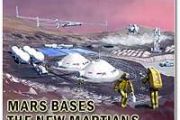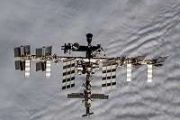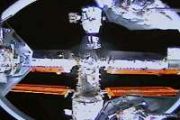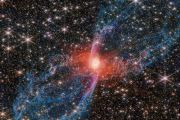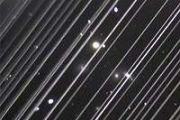
Copernical Team
Terran Orbital assists demonstration of 1.4 Terabyte Single-Pass Optical Downlink for Pathfinder TD3 Satellite
 Terran Orbital Corporation (NYSE: LLAP), a global leader in satellite-based solutions primarily serving the aerospace and defense industries, has announced its contribution to the successful demonstration of a record-breaking 1.4-terabytes of data delivered from space to ground by an optical downlink in a single pass.
The demonstration connected the TeraByte InfraRed Delivery (TBIRD) laser
Terran Orbital Corporation (NYSE: LLAP), a global leader in satellite-based solutions primarily serving the aerospace and defense industries, has announced its contribution to the successful demonstration of a record-breaking 1.4-terabytes of data delivered from space to ground by an optical downlink in a single pass.
The demonstration connected the TeraByte InfraRed Delivery (TBIRD) laser Cosmic ray counts hidden in spacecraft data highlight influence of solar cycle at Mars and Venus
 Measurements by ESA's long-serving twin missions, Mars Express and Venus Express, have captured the dance between the intensity of high-energy cosmic rays and the influence of the Sun's activity across our inner Solar System.
A comparison of data from the ASPERA plasma sensor, an instrument carried by both spacecraft, with the number of sunspots visible on the surface of the Sun shows how
Measurements by ESA's long-serving twin missions, Mars Express and Venus Express, have captured the dance between the intensity of high-energy cosmic rays and the influence of the Sun's activity across our inner Solar System.
A comparison of data from the ASPERA plasma sensor, an instrument carried by both spacecraft, with the number of sunspots visible on the surface of the Sun shows how NASA's Roman Mission completes key optical components
 Engineers at Ball Aerospace, one of the industrial partners for NASA's Nancy Grace Roman Space Telescope, have installed and aligned the element wheel assembly (pictured above) into the telescope's Wide Field Instrument. The assembly contains eight science filters, two dispersive elements (a grism and prism) and a "blank" element (used for internal calibration) that will help scientists solve so
Engineers at Ball Aerospace, one of the industrial partners for NASA's Nancy Grace Roman Space Telescope, have installed and aligned the element wheel assembly (pictured above) into the telescope's Wide Field Instrument. The assembly contains eight science filters, two dispersive elements (a grism and prism) and a "blank" element (used for internal calibration) that will help scientists solve so Sierra Space selected by Maxar to provide solar power solutions for constellation of proliferated LEO satellites
 Sierra Space, a leading space company building an end-to-end business and technology platform in space to benefit life on Earth, reports that the company won a significant space defense contract with Maxar. Under the agreement, Sierra Space will provide revolutionary solar power solutions and production capability.
This contract will support a constellation of 14 satellites that use Maxar'
Sierra Space, a leading space company building an end-to-end business and technology platform in space to benefit life on Earth, reports that the company won a significant space defense contract with Maxar. Under the agreement, Sierra Space will provide revolutionary solar power solutions and production capability.
This contract will support a constellation of 14 satellites that use Maxar' Impact-induced formation of microscopic magnetite first confirmed in Chang'E-5 lunar soil
 A research team led by Prof. LI Yang and Dr. GUO Zhuang from the Institute of Geochemistry of the Chinese Academy of Sciences (IGCAS) conducted in-situ electron microanalysis of spherical iron-sulfide grains in the finest Chang'E-5 lunar soil and has confirmed the presence of impact-induced sub-microscopic magnetite.
The study was published in Nature Communications on Nov. 23.
Magnet
A research team led by Prof. LI Yang and Dr. GUO Zhuang from the Institute of Geochemistry of the Chinese Academy of Sciences (IGCAS) conducted in-situ electron microanalysis of spherical iron-sulfide grains in the finest Chang'E-5 lunar soil and has confirmed the presence of impact-induced sub-microscopic magnetite.
The study was published in Nature Communications on Nov. 23.
Magnet Second Time's the Charm: Sols 3671-3673
 As happens occasionally, our previous plan did not execute quite as expected. There was an issue with the rover's avionics in Wednesday's plan just before MAHLI was to take images of our contact science target "Roxinho." This precluded that imaging, the subsequent drive and observations taken from our remote sensing mast. Thankfully our engineering team here at JPL assessed the fault and felt co
As happens occasionally, our previous plan did not execute quite as expected. There was an issue with the rover's avionics in Wednesday's plan just before MAHLI was to take images of our contact science target "Roxinho." This precluded that imaging, the subsequent drive and observations taken from our remote sensing mast. Thankfully our engineering team here at JPL assessed the fault and felt co Plant on China's Shenzhou-15 spaceship begins growing
 The Arabidopsis thaliana plant boarding on China's Shenzhou-15 manned spaceship has begun growing, the China Science and Technology Daily reported on Monday.
The Shenzhou-15 spaceship was launched at 11:08 p.m. on Nov. 29, 2022. About 20 hours later, Chinese astronauts placed the Arabidopsis thaliana in a biological incubator in the life and ecological experiment cabinet inside the Wentian
The Arabidopsis thaliana plant boarding on China's Shenzhou-15 manned spaceship has begun growing, the China Science and Technology Daily reported on Monday.
The Shenzhou-15 spaceship was launched at 11:08 p.m. on Nov. 29, 2022. About 20 hours later, Chinese astronauts placed the Arabidopsis thaliana in a biological incubator in the life and ecological experiment cabinet inside the Wentian Methods for building lunar landing pads may involve microwaving moon soil
Giant mantle plume reveals Mars is more active than previously thought
 On Earth, shifting tectonic plates reshuffle the planet's surface and make for a dynamic interior, so the absence of such processes on Mars led many to think of it as a dead planet, where not much happened in the past 3 billion years.
In the current issue of Nature Astronomy, scientists from the University of Arizona challenge current views of Martian geodynamic evolution with a report on
On Earth, shifting tectonic plates reshuffle the planet's surface and make for a dynamic interior, so the absence of such processes on Mars led many to think of it as a dead planet, where not much happened in the past 3 billion years.
In the current issue of Nature Astronomy, scientists from the University of Arizona challenge current views of Martian geodynamic evolution with a report on NASA's Orion spaceship slingshots around Moon, heads for home
 NASA's Orion spaceship made a close pass of the Moon and used a gravity assist to whip itself back towards Earth on Monday, marking the start of the return journey for the Artemis-1 mission.
At its nearest point, the uncrewed capsule flew less than 80 miles (130 kilometers) from the surface, testing maneuvers that will be used during later Artemis missions that return humans to the rocky cel
NASA's Orion spaceship made a close pass of the Moon and used a gravity assist to whip itself back towards Earth on Monday, marking the start of the return journey for the Artemis-1 mission.
At its nearest point, the uncrewed capsule flew less than 80 miles (130 kilometers) from the surface, testing maneuvers that will be used during later Artemis missions that return humans to the rocky cel 



